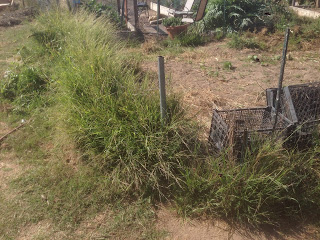Run any construction plans you have by one of
the garden managers. There are materials that aren’t appropriate for our organic
garden for reasons which may not be immediately intuitive to you. Design-wise, our goal is
to have people build functional infrastructure that will last and be beneficial
to future gardeners. I think this is the #1 thing that people get wrong. We definitely do have animal problems, but which animals are the issue evolves over the seasons and over the years, so permanent "solutions" do not make the most sense. I took a walk through the garden taking some photos and I'll discuss the good and bad of certain designs. Also, these are the animals I consider destructive: mice, voles, rats, squirrels, rabbits (new this year), birds, tomato horn worms, cabbage moths, caterpillars, aphids (you can't keep out insects with a cage...). In general younger plants should always be protected, many older plants don't as the leaves become less palatable, although their fruit may be taken (though this is hard to protect).
I'll start with my plots, L1, GBH2
I'm currently re-working this plot and am taking out the 3' tall permanent cage. This dates from the days when the garden was overrun with squirrels, and doesn't really serve a purpose anymore. The good thing about the design are the side doors front and back so I can reach in and pull weeds. The bad is it's not built that well and critters can get in, and it's still a hassle to weed as the door on the backside isn't super functional.
I'm growing sweet potatoes inside of the cube of 1" hexagonal wire. Squirrels and rats love sweet potatoes - both the tubers and the foliage. 1" wire seems to work.
I have a couple of miscellaneous smaller portable cages that I've built over the years. I use them on seedlings to keep birds, bunnies, etc off. I also tend to protect beans throughout their life.
bunnies were eating young pepper plants, eggplant, tomatoes also
super simple cylinders of 1" hexagonal chickenwire to keep bunnies out. A fence around an entire raised bed could work but rabbits jump pretty high, at least 2', and to me leaning over a fence is a hassle. Also if rats or squirrels are a problem you need full cages and it's way easier to put a top on a cylinder of wire than it is to put a top on a fenced bed, see below.
Laurie's plot, L10
Laurie's husband is a retired engineer, which means he has time and likes to build stuff. He did a nice job, though again these designs date from the time squirrels overran the garden so aren't necessarily necessary. The bottom design is better than the top one in my opinion. I don't like removable tops because if you have things that grow vertically you'll have to remove the tops or you won't be able to get in, and then birds, squirrels, rats can all get in, too. Having side opening doors allows you to access the cage when stuff grows through the top, and you're protecting most of the plant. Also the door hinges from the top so gravity keeps it closed. I like that the wire wraps around the wood, strengthening everything.
Peter 29
This isn't a good design, it looks nice but it's overkill and isn't going to last. I like the side opening doors but the latch comes undone and sometimes they are wide open. There's no top so the only thing it is keeping out are rabbits and there are much easier/cheaper ways to keep rabbits out. The wire is in panels and lots of 1x1s are used in the doors, so I don't think the doors will last.
Woodpecker 4
In the foreground are nice, simple designs. The only issue is there are some gaps at the ground level that an enterprising critter could get through. Some garden staples (pic below) would help. The cage in the back is a nice portable cage that can be moved easily to new plants or to weed the area it is currently protecting.

I use these black plastic trays when I direct seed seeds (for instance carrots or beets). It helps keep the soil moisture high for germination and keeps critters off. The trays in the pic are pretty open, there's another type that has much smaller holes, I prefer those. I'll leave them on until the foliage is poking through the top. Often you can find these in the greenhouse.
























